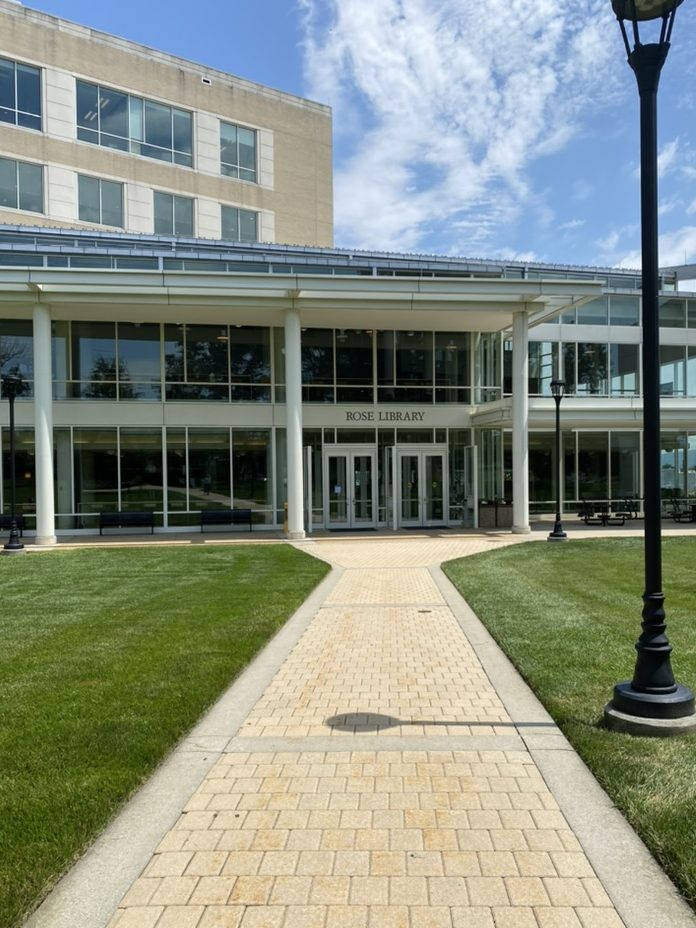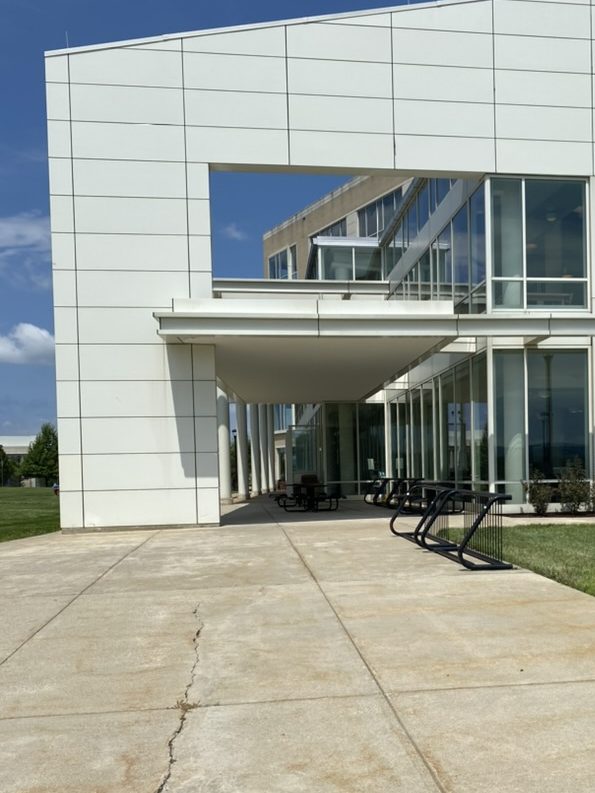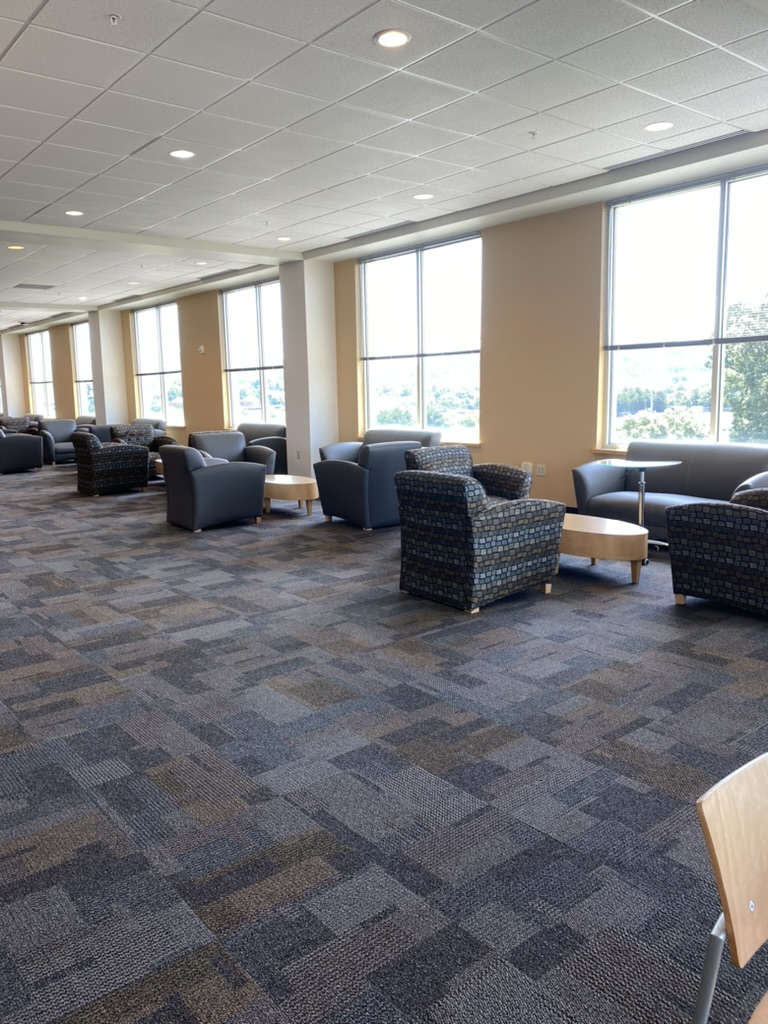Rose Library – James Madison University


Space and Physical Access
Rose Library is one of three academic libraries located on the James Madison University campus in Harrisonburg, Virginia. This library is located on the east campus which is comprised of math, science, business, technology and engineering buildings. The library was built in 2008 and has a modern look. The front part of the building is three stories high, consists of a lot of glass, and has an interesting wall on the side. The back part of the building is five stories high and brick, with numerous large windows. The building is surrounded by beautiful mountain views. There are benches and tables in the front of the library as well as bike racks. I was able to connect to WI-FI from this area. Two other benches are a little farther away on a patio-like area. There are a lot of grassy areas surrounding the front and sides of the building. These areas consist of many trees which make available both sunny and shady areas. There are staff and commuter parking lots across the street from the library. The city bus also stops nearby. Visitors to campus during the week need to get a parking permit in order to park on campus without getting a ticket.
The front of the building is handicapped accessible with no stairs and automatic doors operated by a push button. As I entered, I noticed how bright, open, and inviting it is. Across from the front doors is a large information desk. This is the main area to go for any type of service. To the left of the desk, there are many tables and chairs of different heights. In addition, there are groups of comfortable chairs with small tables arranged in circles. Also on this side is a Starbucks and a glass enclosed 24-hour study room with tables, chairs and lockers. To the right of the information desk are multiple seating areas with computers. As I continued around the corner I came to the Makery. This is available to all students by appointment. The person in charge said they try to have different technologies and equipment that students may not have an opportunity to own. The Makery includes printers; scanners; 3D printers; art areas with paints; button and jewelry making; sewing machines; material cutting table; iron and ironing board; instruction and idea texts; wood and metal lasers; a Cricut machine; and more. All supplies for these areas are also provided.
Each floor, which is accessible by stairs and an elevator, has a variety of seating areas and is very bright with natural light from large windows. The views of the surrounding mountains as well as the City of Harrisonburg are beautiful. There are open seating areas as well as more secluded, individual study areas. The second through fourth floors contain group study rooms and there are two library classrooms on the third floor. The fourth floor is designated as a quiet study floor. The top floor includes media production services, online learning assistance, and staff offices. There are a few comfortable chairs in a circle on this floor. A staff member said that students who really want privacy and quiet will come up to this area on the fifth floor. A lot of the furniture in this building is able to be moved and arranged as desired. According to Mathews and Soistmann (2020), this ability to modify the space meets both functional and emotional desires (How does this space make you feel? section, para. 6). They also state that “A chair is more than just a place to sit . . . and has a direct impact on the pursuit of learning” (Mathews & Soistmann, 2020, How does this space make you feel? section, para. 7). While there are books on the first through fourth floors, they don’t stand out as the main focus of the areas. The various open and closed student meeting/study areas are what define this library. According to Rubin and Rubin (2020), today’s academic libraries contain more open spaces and have become more of a learning space than a storehouse of information (pp. 136-137). This is definitely true and obvious in the Rose Library.

Collections / Services / Intellectual Access
Because the Rose Library is on the east campus of JMU which focuses mainly on sciences, math, technology, and engineering, the major resources in the collection focus on these subjects as well. Collections include science, health, math, engineering, technology, and business materials. The books in the collections are classified using the Library of Congress Classification System. There are signs posted on each floor explaining how the collections are organized, how to read the call numbers, and what study areas are available.
There is a number of different technologies available. I have already discussed the different technologies in the Makery. In addition, there are numerous computers, printer, scanners, and Zenbooths with wall mounted screens. According to the website, there are accessible technology labs for those with vision and hearing impairments.
People – Patrons and Staff
Since this is an academic library, the Rose Library’s main patrons are the students, faculty and staff of JMU. However, the library is open to the community and everyone is allowed to check out materials and use the technology. This being summer, there were not a lot of people in the library. I saw some students in a group study room and a few individuals on each floor, except the fifth, either reading or on a computer. There was a range of ages, genders and races.
I observed about six staff members working in the library. While they were both male and female, they were all white. I saw information about liaison librarians with their pictures. They were also all white. I looked at the list of library staff on the JMU library website. The employees for all campus libraries are listed together. There are 131 staff listed with 95 having pictures. Of the staff that had pictures, approximately 10% appeared to be non-white and about 38% were men. This supports the Rubin and Rubin (2020) statement that “The lack of diversity in the library labor force remains a serious problem” (p. 306).
Digital Access
https://www.lib.jmu.edu/spaces/rose-library/
There is a main James Madison University Library page as well as links to pages for each individual campus library. Services from the main page include ask a librarian, catalog search, interlibrary loan, databases, journals, and research guides. The catalog search is available to the public. There is a link to the library staff page. This page includes emails and phone numbers for each staff member. The most surprising job title to me on this page was Faculty Associate from Occupational Therapy. Another way to interact with staff is through social media. There is a link on the main library page to a social media channels page.
According to the website, accommodations are available for those who are visually impaired, blind, or print disabled. These accommodations include SensusAccess which converts documents into other formats and HathiTrust which provides reading access to digitized books.
There are many links to other pages which in turn offer links to more pages. While there is a lot of information available, it can be overwhelming and time consuming to find what you are looking for.
Final Take Away
I am an alumna of James Madison University but graduated before Rose Library was built. I was excited to visit this library. Overall, I was pleased with what I found. It is beautiful inside and out. It seems very learner centered, welcoming, and comfortable. However, even though I had read about the lack of diversity in libraries, I was still surprised and disappointed in the lack of diversity in the JMU Library staff.
References
Mathews, B. & Soistmann, L. A. (2020, September 1). Encoding space – shaping learning environments that unlock human potential. American Libraries. https://americanlibrariesmagazine.org/2020/09/01/encoding-space-library-design/
Rubin, R. E., & Rubin, R. G. (2020). Foundations of library and information science (5th ed.). ALA Neal-Schuman.
Tina,
It was interesting to learn about JMU’s Rose Library, and that there were several campus libraries. I was particularly interested in their Makery. I’ve never heard of something quite like it before, but love the idea of the wood and metal lasers being available to use. I was similarly impressed by a sound booth available for reservation/use that I saw at the Perry Library at ODU. I think I am going to have to research Zenbooths, as that was also new to me. Did you actually notice any of the students had rearranged the furniture as it seemed to be intended for while you were there?
Kiley,
I didn’t see where any students had rearranged the furniture while I was there. Being summer, there were not a lot of students there. The ones I saw were sitting at tables or individual cubicles. The Zenbooths are soundproof privacy booths.
That Makery sounds really awesome! I love all the windows in your pictures. It sounds a lot like the ODU library with the open lounging space at the entrance of the floors and the books ect in the back.
Thanks for this tour Tina. The outside area sounds really pleasant, and the building is fairly new which is nice. The indoor spaces look very appealing too. I haven’t been on JMU campus before but I’ve driven past it. The Makery sounds very cool! I am super impressed with that space! Wood and metal laser cutters-too cool!! I want to go there and create something cool. :). I’m still wondering about this lack of diversity in staffing, as so many have mentioned in their library visits that staff is pretty white (and more female than male). Is it the state we live in-Virginia? Or is it the profession? I’m still thinking about this one.
Liz,
That is a good question. From what we have read in Rubin and Rubin, I would assume it is the profession and not just Virginia.
This library sounds amazing, I will definitely be checking it out next time I am up in Harrisonburg. I’m envious of the Makery. Can members of the public use the Makery or is intended for staff, students, and faculty only?
Jordan,
From my understanding the makery is just for students and staff of JMU.
Thank you for the lovely tour of JMU! I am very much enjoying learning about all the academic libraries. Their makerspace sounds very nice! It’s very interesting how many universities have mutable libraries on campus depending on the degrees. I went to ODU for my undergrad and I only remember the main library and the music library. It has been years since I have been on campus though so there might be more.